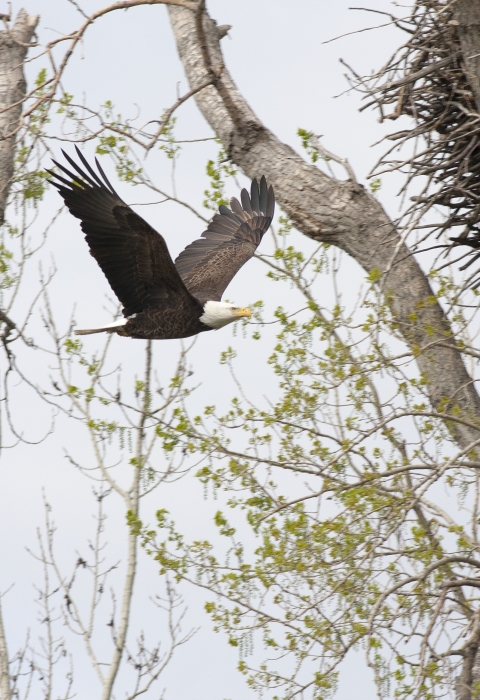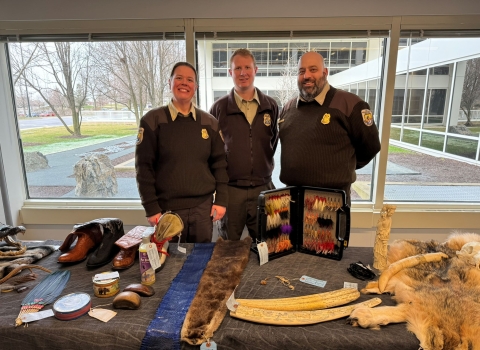Cameras that provide live coverage of nesting bald eagles to the Internet have become a popular educational tool. However, because there is the potential for eagles to be disturbed by the process of camera installation and operation, or by people visiting the nest site, the U.S. Fish and Wildlife Service (the Service) developed the following guidance for the use of cameras at bald eagle nests.
*At this time, the Service does not recommend the use of such cameras at golden eagle nests.
How are eagles and their nests protected under federal law?
Both bald eagles and golden eagles and their nests are protected under the Migratory Bird Treaty Act (MBTA) and the Bald and Golden Eagle Protection Act (Eagle Act). Both laws prohibit “take” and possession of eagles, their parts, nests, and eggs. Under the Eagle Act, “take” includes disturbance.
Is there a legal definition of what it means to “disturb” an eagle?
“Disturb” is defined by regulation 50 CFR 22.3 as “to agitate or bother a bald or golden eagle to a degree that causes, or is likely to cause, based on the best scientific information available, (1) injury to an eagle, (2) a decrease in its productivity, by substantially interfering with normal breeding, feeding, or sheltering behavior, or (3) nest abandonment, by substantially interfering with normal breeding, feeding, or sheltering behavior.”
Is a permit required to install and operate a camera at a bald eagle’s nest?
If the camera is installed and maintained following responsible protocols, this activity will not result in bald eagle disturbance or other take, and a federal permit is not required. The most critical factor for ensuring that no disturbance occurs is that the camera be installed outside the breeding season when the nest is inactive. Installation or maintenance of the camera should not be undertaken during the nesting season because of the increased probability that the eagles would be disturbed, in violation of the Eagle Act.
Some states may have laws or regulations that require a state permit to install a camera at an eagle nest, while others may simply want to be made aware of the camera. You may visit your State Wildlife Agency for additional information. Please note that landowner permission may need to be obtained, as well as approval from local government and/or tribal entities.
When is the breeding season for bald eagles in different parts of the U.S.?
The bald eagle breeding season can begin several months before egg-laying. The nest building and courtship period is an important part of the breeding season, and disruption of those activities can constitute a prohibited disturbance in violation of the Eagle Act. Breeding seasons vary for bald eagles by regions in the United States. Because the timing of nesting activities may vary within a given region, you should contact your regional Migratory Bird Office and/or your state wildlife agency for more specific information on nesting chronology in your area. You can also review the National Bald Eagle Management Guidelines for nesting date by region.
Can the camera be adjusted or repaired during the breeding season?
If the nest camera malfunctions during the breeding season, wait until after the breeding season is over to do any on-site maintenance in order to avoid disturbance. The exception is if emergency maintenance is needed to protect the eagles or nest tree (e.g., hurricane winds dislodge the camera or wiring to a position that endangers the eagles). Except for such emergency circumstances, the Service will not issue permits to cover disturbance associated with camera maintenance. Assumed risks for installing cameras at bald eagle nests include that the camera (and associated website) may fail.
If something happens to the eagles, will the Service issue a permit to rescue them?
The Service will not issue a permit that authorizes interference with the natural course of events at the eagle nest. Web camera operators may want to put a statement on their website informing viewers of this. Eagle nestlings do not always survive. Adults may also be injured in territorial disputes with other eagles or by other natural factors. If the web camera operators do not want to expose the public to these types of natural occurrences, they can discontinue the live video feed.
Does the Service have recommendations about how to install the camera, where in the nest tree the camera should be installed, and other technical aspects of camera installation?
Our most important recommendation is that camera installation be conducted by a qualified, knowledgeable individual who has eagle/raptor expertise and arborist or nest entry experience. This person should be experienced in how to install the camera at a safe distance from the nest so that it does not interfere with eagle activity or the safety of the eagles and the integrity of the nest site. They should also be familiar with how to camouflage the camera, protect it from the elements, and other technical considerations that will ensure the safety of the eagles and prevent disturbance.
Can I collect and possess any part of the bald eagle’s nest, feathers, eggs, dead eaglets, etc. from in or around the eagle’s nest that I may find when installing the camera?
No, you may not collect eagle or nest parts. Both the MBTA and the Eagle Act prohibit collection or possession of any birds, their parts, feathers, nests, and eggs without a permit.
Are there concerns about making the nest site location known to the public?
The Service recommends that the location of the nest not be shared to prevent unintentional disturbance from well-meaning citizens. If the location is publicized, we recommend posting a notice advising people to keep a safe distance from the nest to avoid disturbance.
To learn more about bald eagles and their management, please visit our eagle management page.
Additional questions may be directed to Migratory Birds Regional Office nearest to your state.



